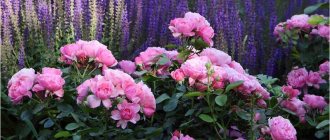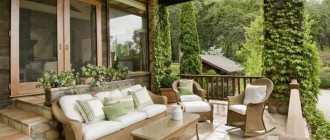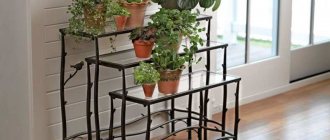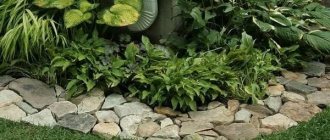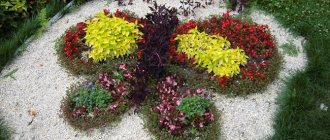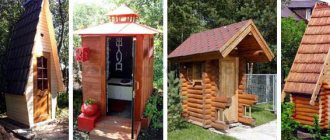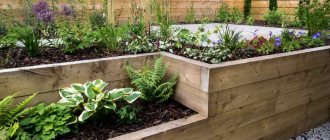Review author: Terrari School of Design
Many people try to arrange a flower bed in their garden with their own hands. This solution will allow you to beautifully and originally decorate your local area and enjoy the flowering of plants from early spring until frost. Let's look at all the secrets of designing flower beds in detail.
Basic principles of creating a flower garden
When designing a picturesque flowerbed, you should focus on a number of rules for its rational design and understand the terminology. There are mainly two groups:
- Flower beds that have a regular shape with strict geometric parameters;
- Varieties of flower beds of any, sometimes the most unexpected configuration.
Development of a flowerbed project at the dacha
At the project development stage, we are guided by specific principles:
- Integrity. To create a harmonious image of the future design of the dacha area with the help of plants, you should consider the shape, color combinations, and the need for fencing.
- Multi-tiered. Flowers play a dominant role in decoration, so it is important to provide an overview of each plant. Low-growing varieties are placed at the front edge or along the perimeter.
- Thoughtful scheme. There are many options for creating flower beds. It is important to organically fit the selected type of flower bed into the surrounding landscape.
Fashion trends and new items
Designers are constantly finding new solutions for designing flower beds and flower beds. Basic principles of fashion trends:
- monochrome in colors;
- color spots - bright small flower beds with flowers of the same shade;
- flower beds of the “flower clock” type - flowers simultaneously open or close their cups;
- cake-shaped flower beds - round areas separated by radial lines;
- dwarf coniferous flower beds - use low evergreen (coniferous) shrubs;
- volumetric figures - create vertical compositions on a frame basis;
- multidimensional 3D flower beds with additional lighting effects;
- portable (mobile) flower beds are various types of flowers that are planted in separate containers, taken out into the garden in the summer, and put away in warm rooms in the winter.
Amateur flower growers can use these techniques when creating their own compositions in summer cottages or on the territory of country houses.
Flower beds and flower beds at the dacha
When independently planning the design of a summer cottage by placing flower beds on it, you should analyze information about the dominant varieties of such a landscape element.
Flower border
A flower border is a picturesque narrow ribbon of beautiful plants. Placed along paths or serves as the border of functional areas. It is often used to mark the boundaries of a rock garden or large flower beds.
Most often, low compact plants are used for planting, which are excellent for these purposes. In addition, they take root better in the ground without requiring special care.
With flowerbeds in the form of a border, your site will look well-groomed and beautiful.
Beautiful flower beds are a traditional element of a modern garden.
Bright, juicy succulents are perfect for decorating flower beds and paths in the country.
Rabatka
A ridge flower bed is a traditional type of flower bed with a strict rectangular shape. Plants are selected in different shades or prefer a single-color background.
Planted varieties can have different variations in both shape and height.
Mixborder
Used to decorate the space along the walls of buildings. A correctly selected floral pattern will give a charming appearance to even the most inconspicuous building.
In this case, it is allowed to plant different varieties of flowers and plants, the care of which is not particularly difficult.
The dominant option for mixed border flower beds is the selection of ornamental crops that ensure continuous flowering. Making such flower beds at your dacha with your own hands is very simple, since it does not require any special skills.
Vertical flower bed
A vertical flower garden allows you to beautifully and rationally design small areas.
A vertical flowerbed in a dacha is attractive due to its original design and many compositional options.
Interesting shapes can be obtained using wire mesh frames covered with film and filled with soil mixture. Such flower beds look good near verandas and terraces attached to the house.
The base for a vertical flower bed can be bought at a specialized store or made independently using available material.
An unusual wooden flower bed made in the form of a quadrangular pyramid will appeal not only to you, but also to your children.
The pyramid flowerbed can be used as decoration both indoors and outdoors.
Vertical flower beds made from pallets will look impressive in the courtyard of a private house.
Another simple, but quite interesting option for creating a vertical flower bed is obtained using pots of different sizes.
To fix the pots in a vertical position, a metal rod (reinforcement) is used, which is threaded through pre-drilled holes in the bottom.
Pots arranged in a chaotic manner look more interesting.
carpet flower bed
Typically, such flower beds are located against the backdrop of pebbles, lawns, sandy areas, but they can be placed in any other place, the main thing is that the carpet flower bed in the dacha fits harmoniously into the overall landscape design of the yard.
Guided by the ideas of experienced designers, it is possible to create interesting ornamental patterns that create the feeling of an expensive carpet spread out in the yard.
The photo shows what carpet flower beds you can make with your own hands in your dacha.
A snail crawling through a flower meadow will give your home area an absolutely fantastic look.
Making a flower bed of perennials
A bed of perennial flowers requires care, although they do not need to be planted annually. Overgrown plants need to be planted, pruned, dry leaves and shoots removed, and weeds removed.
Recent Entries
Lilac perennials that are beautiful, compact and do not crowd out other plants Why when buying seedlings you should not take the sellers’ word for it and how to determine the age of the plant using 3 signs Tomato seedlings have turned purple or whitish: why the color has changed and how to save the plants
The first to bloom among perennials are bulbous ones - hyacinths, tulips, daffodils, and irises. The first grass has just appeared, and their delicate leaves, shoots and flowers paint the garden with festive colors. A flower bed made up of bulbous plants is magnificent in any case, no matter what flowers you use. Scilla will be the first to hatch, then it will be time for hyacinths, muscari, daffodils and tulips. For a flower bed, you can only use flowers of one variety - for example, varietal tulips.
A selection of the best varieties of bulbous perennials will also be useful:
Use your imagination. If you find a couple of large boulders, place them in the garden. You can make such a fragile, beautiful composition by planting varietal tulips between them
But combinations of bulbous plants also look very good - you can plant tulips and daffodils in rows, or beautifully combine the delicate blue of muscari with groups of plain or colored tulips. Plant several hyacinths of different colors in a small area - you will see what a wonderful corner it will be. Don't forget about irises - these are royal flowers. If possible, plant irises of different colors in rows, or using flowers of different shades in a circular bed. For example, purple around the edges, fawn in the center.
Bulbs quickly fade, followed by primroses almost immediately. These are unpretentious flowers with a rich palette; we advise you to use them to create a flower garden. Ready-made flower bed schemes from perennials will allow you to create luxurious flower beds that will delight you all summer:
This flowerbed is good because it can be arranged both in the shade and in the sun. Boulders look good in the company of irises and astilbe
To create this flowerbed of perennials you will need the following flowers - background: 1 - hollyhock, white, red, yellow, 2 - ten-petalled sunflower, 3 - Icelandic poppy, 4 - inodorous St. John's wort, 5 - cardinal lobelia, 6 - Fassin's catnip, 7 - Poskharsky's bell, 8 - blue catananche, 9 - gravilat 'Feuerbal', sedum 'Matrona' blooms in the fall - 10, 11 - blood-red heuchera. A combination of yellow, shades of blue and blue, red
Varieties of flower bed shapes
- Geometric. They have a clear outline and correct configuration.
- Natural. They represent a free outline, imitating the free arrangement of plants.
- Elevated. They are created inside high fences, giving an unusual decorative design.
- Monochrome. In such flower beds one variety of plants is grown.
- Multi-tiered. Special structures with several levels are pre-installed. Flowers and green ornamental plants are planted on them. Usually compact varieties are selected.
- Symmetrical. They bring orderliness to the landscape.
- Combined. There are countless combination variations in color, shape, and height.
How to make a multi-tiered flower bed
Another type of spectacular planting at the dacha is a multi-tiered flower bed for growing hanging plants. You can create it from suitable containers of different shapes, ready-made shapes, tires, boards, stone, even broken furniture. The main condition is that the plantings should be arranged in tiers, one above the other.
Popular articles Corals and shells in the interior of the house
- First, the area for the flower bed is prepared.
- The first tier is being built. It should be the strongest and most stable - it will bear the weight of the entire structure.
- The next tiers are installed one above the other so that there is space left to fill with soil.
- Selected plants are planted in the resulting “pockets” of soil.
- A multi-tiered flower bed is watered in stages, starting from the very top.
Numerous photos of flower beds at the dacha fill the Internet. From there you can get a lot of ideas or come up with your own unique options.
Stages of creating a flower bed in the garden (step by step)
It is recommended to take time to create a design for future floral objects. This will prevent you from being disappointed in the future due to possible disharmony.
Sequencing
- Analyze a variety of illustrative material using printed and electronic publications on landscape design.
- Determine your preferred color scheme. The further acquisition of flower seeds depends on this.
- The location of flower beds is chosen depending on the characteristics of the plants. If they love light, then place the flower beds away from trees and tall buildings.
- Provide an approach for providing care. Shade-tolerant crops will be comfortable near walls and fences. They mark the entrance to the site.
Often planted next to the gazebo or in tree trunks.
- They think about the configuration, the presence or absence of decorative fencing. Create a scale diagram of the site and draw all the planned flower beds on it.
- Make sure to make a plan in color, which will allow you to correct unsuccessful combinations if necessary.
2.1. Sociological survey
A group of sociologists conducted a sociological survey among students and teachers of our school on the following questions:
- Do you like our school yard?
- Would you like to take part in the improvement of school flower beds?
75 students and 12 teachers took part in the social survey.
2.2. School yard survey (pre-project analysis)
On the school yard there are four small flower beds and one large one. A large flowerbed is located along the school; the borders of the flowerbed are partially bordered by a protective strip of trees. The flowerbed has the shape of a rectangle measuring 18 by 6 meters,
well lit, has a flat surface, the depth of the arable layer is about 30 cm. The soil is loamy. Mineral and organic fertilizers were not applied. There is contamination of the area: creeping wheatgrass, field sow thistle, dandelion and others.
The flowerbed is clearly visible from all sides and the beautiful design will be observed from the school windows and from the street not only by students and teachers, but also by school guests.
Landscaping plan for the school site
MKOU Bazhinskaya secondary school
- trees, shrubs
Which plants to choose
In the process of creating flower beds that organically fit into the overall style of the landscape, it is necessary to be guided by several principles.
Rules for arranging flower beds
- Plants are selected in a contrasting or harmonious combination of similar colors, taking into account not only the color of the petals, but also the shape and size of the plant.
- It is not recommended to create excessive spice. Usually no more than four varieties are placed in one flowerbed.
- The height of the selected flower crops is taken into account, placing low-growing varieties at the forefront.
- The highest aerobatics of landscape art is considered to be the provision of a continuous change in the color background, thanks to the planting of varieties with different periods of bud formation.
- Giving preference to perennials, they turn to zoned varieties that can withstand the winter seasons without damage.
Plants such as clematis and peonies can grow without replanting for several decades, delighting with abundant flowering.
On a note! The advantages of perennial flowers also include easy care and low financial costs, since there is no need to purchase new seedlings every year.
Among modern trends, several color options for flower beds attract attention:
- Monochrome. Involves the selection of shades of different saturations of the same color. This group also includes plants with decorative foliage, the variety of which varies from silver-green, ant, malachite, lemon to pearl tones.
- Green and white combinations. To create such a fresh sound, primrose, peonies with white inflorescences, and hydrangea are planted. Mock orange and spirea add charm to the site.
- Green-pink version. Chrysanthemums, clematis, charming roses, and astilbe create unusually delicate and imaginative tints in this range. You can plant decorative barberry and bergenia.
- Monoformality. It involves placing varieties that have a single shape in one flower bed. An interesting option is the round crown. For example, blue fescue, standard roses, and large-leaved hydrangea are planted. The spherical thuja adds charm and amazing grace.
- Contrast. To solve such a problem, which involves an unusual, very bright sound, flowers are planted that have, for example, yellow and purple colors. Burgundy and blue buds create a striking contrast.
A fashionable option remains the blue-yellow combination, for which irises of different varieties, viola, delphinium, and daylily are suitable.
Classic low flower bed
The standard solution remains a low round flower bed on which flower crops selected according to a specific plan are placed.
For marking, use a rope, which is tied in the center of the future structure and with the help of a peg, a circle is drawn on the other edge. Select soil to an average depth of 25 cm, while trying to completely level the surface.
Advice! To protect the plantings from difficult-to-eradicate weeds, the mole cricket and the bottom of the excavation are lined with geotextiles.
If the soil on the site is heavy loam, then additional gravel drainage is placed, creating a layer about 7 cm high. Then a soil mixture is prepared, combining the excavated soil and rotted compost.
At the same time, phosphorus-potassium fertilizers are added, calculating that 25 grams of this drug will be required per square meter.
The prepared soil substrate is laid out on a drainage pad so that the edges of the future flower bed are raised above the ground surface. If necessary, decorative fencing is installed to protect the embankment from being washed away by rain and giving it a special decorative effect.
Flowerbed design schemes
By selecting different plants and combining them, you can create an almost endless number of variations of a simple but very effective flower bed. But if you are new to this business, then it will be easier to use ready-made options and simple schemes for creating flower beds.
- Central flower bed - this scheme is the simplest for organizing a flower garden. It consists of circles. The center is filled with cannas with dark leaves, which are the soloists of the entire composition, then green-leaved cannas are planted around the border in a circle, the third row is filled with decorative leafy gnafalium and this parade is completed by snapdragons.
- Viennese flower. To create this option, you will need to arrange a six-leaf flower in the flowerbed, the center of which will be white gillflowers, the border of which will be alpine forget-me-nots. It is good to organize the outer edge with islands of viola, zinnia, and primrose.
- The whimsical pattern is a round flowerbed, which is decorated with a large number of wavy elements decorated with variegated, sun-loving perennials. In the center of such a flowerbed you can place a squat chamerops with a beautiful crown of fan leaves. Its shadow will be a good background for the dahlia zinnia, and the coleus will act as a contrast. Fancy curls can be created using begonias and pelargoniums, which will look very impressive against the background of lawn grass.
The proposed schemes are just a few options out of many. Or maybe you already have your own creative ideas for decorating a beautiful flower bed - an amazing decoration for your site?
Using stones in garden design
An original way to add something exclusive to the landscape of a summer cottage is to use natural stones in its design. There are two main types of flower beds using stones: rock gardens and rock gardens.
The difference between them is that in a rock garden the emphasis is on stone blocks, and in a rock garden on flowers and plants.
How to make a rockery
Large boulders are placed on a flat area in a pre-designed order. The largest of them are dug into the soil, making the composition look more natural.
After this, smaller stones are laid out in small groups.
When creating a rock garden, it is advisable to use stones of the same type: sandstone, granite, slate, limestone, tuff. The space between the boulders is filled with sand, gravel or fine crushed stone.
It is recommended to make the background bedding in a color contrasting with the stone blocks.
Plants are planted last.
They should not dominate the rock garden, so it is better to plant hardy species that do not attract much attention: decorative onions, gorse (Spanish gorse), pampas grass, gray fescue or other cereal crops for the garden.
How to make a rock garden
Stones are also used to create an alpine slide. They are laid out on a pre-filled earthen hill, and suitable vegetation is planted in the gaps: saxifrage, tenacious, stachys and other ground cover plants.
Bright creeping and low-growing perennials are also used: aubrietta, rezuha, carnation grass, gentian and others.
Creeping juniper, dwarf pines, and boxwood look very good in the rock garden.
The height of the slide can be different, from half a meter to 2 meters. It all depends on the size of the dacha plot. If the rock garden is not high, it is better to make it against the background of coniferous plants, for example, spruce, thuja.
Advice. To prevent the germination of weeds, the area under the rock garden is covered with geotextiles. Holes are made in it in places where plants are planted, and the rest of the area is covered with stones.
Designing a site for ornamental plants
A flowerbed is a piece of land on which flower and herbaceous plants are planted. The shape of such a section is limited to straight, round, wavy or winding lines. They correspond to the ideas of the designers or the gardeners themselves. This could be a flower garden in the shape of a “star” with monochrome flowering crops. In other cases - a round (square, oval) composition in which many different colors and shades are combined.
The first step in setting up a flower garden is to clearly design the area for the flowers. To do this you need:
- choose a separate place for planting a flower bed so that in the future the overgrown plants do not interfere with the passage through the garden and do not shade other plantings;
- draw up and sketch a diagram, where to draw the shape and write down the dimensions of the site;
- plan what flowers will be planted;
- determine the general color scheme of future ornamental plants.
You can draw up a project and keep it “in your mind,” but in order not to forget the smallest details, it is better to sketch everything out on a sheet of paper that will always be at hand.
If you don't have time to care for your flower garden
It so happened that visits to the dacha are not regular. Because of this, flower beds are not always cared for on time. In this situation, the Moorish lawn comes to the rescue.
It should be noted that it has very little in common with a regular lawn. Firstly, he does not need constant haircuts, and secondly, he is very elegant. The Moorish meadow (or lawn) consists of 70% cereals and field grasses and 30% unpretentious garden flowers.
The lawn continues to bloom all summer, so it looks great throughout the summer season.
The main plants used in creating the Moorish meadow are:
- Field poppy;
- Cornflower;
- Echinacea;
- Scabious;
- Tansy;
- Nigella;
- Decorative bow.
Attention. When selecting plants for a flowering lawn, their habit should be taken into account. They should all be approximately the same height and none should dominate.
Monoclumba - stylish and simple
Traditional lawns can easily be enlivened with a monoflower - a small flower meadow on a green, clipped carpet. In the center of the lawn, the soil is removed along with the grass, the area is fenced off with a flexible border, and the interior space is filled with fertile soil mixture.
In the resulting “window” any flowers suitable for the country landscape are planted.
If bulbous plants (tulips, daffodils) are used, after they have finished flowering, bright annuals can be planted in the monoflower bed: petunia, viola, tagetes, zinnia, celosia and others.
Majestic roses and graceful cannas look very beautiful on the green lawn.
Plants with variegated (variegated) foliage will help create an unusual composition, for example, creeping species of euonymus fortunena, variegated brunnera, some types of hosta, ivy-leaved budra.
At your dacha you can create just one small flower bed or several types of flower beds. In any case, they will decorate the area, uplifting the mood and conducive to relaxation.
How to create a flower bed with perennial flowers that bloom continuously?
- It is necessary to carry out work on planting perennial plants, creating a flowerbed of continuous flowering, in the fall - this way the plants will take root and bloom within a few months, with the onset of spring. At the same time, bulbous plants are also planted that overwinter in the ground, for example, daffodils with crocuses, tulips with galanthus, hyacinths and scylla.
- If you are already growing perennials, then you have decided how adaptable they are to the conditions and the sequence of their flowering. This way you can form the basis of an ever-blooming flowerbed, and if your flower beds have moments when flowering is not observed, purchase flowers that bloom during these periods so that they fill these “gaps”.
- identical specimens with early and late flowering periods in such an ever-blooming flowerbed , especially if you like this or that flower - this way you will prolong the pleasure of admiring them. For example, from the beginning of May your eye will be pleased with dwarf varieties of irises, and at the beginning of summer - tall beauties.
- You can also supplement a continuous flowering bed with annuals that have a long flowering period: salvias, verbena, marigolds, petunias , etc. They will perform two functions at once: they will become a wonderful bright accent until the perennial plants bloom, and they will “cover” those places where the plants have been damaged by pests or an unsuccessful wintering.
For permanent beauty in the flowerbed
